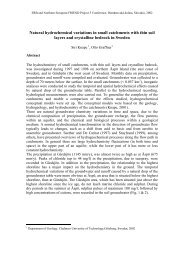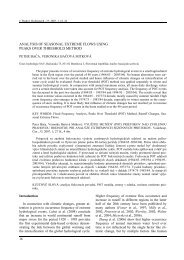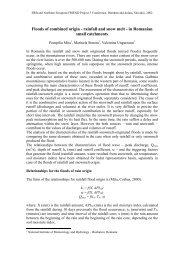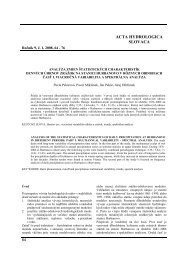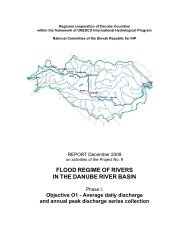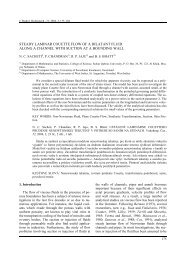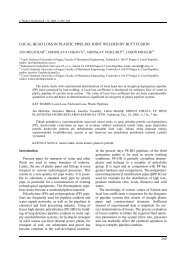TIME SERIES ANALYSIS OF HYDROLOGIC DATA FOR WATER ...
TIME SERIES ANALYSIS OF HYDROLOGIC DATA FOR WATER ...
TIME SERIES ANALYSIS OF HYDROLOGIC DATA FOR WATER ...
You also want an ePaper? Increase the reach of your titles
YUMPU automatically turns print PDFs into web optimized ePapers that Google loves.
D. Machiwal, M. K. Jhaexistence of actual trends and/or discontinuities inthe series affects the sensitivity and have a repercussionon the results of the tests. This analysissuggested an adequate confidence level and theneed of the use of relative homogeneity tests.Webb (1996) analyzed the future trends in watertemperatures from different parts of the world. Thepotential causes of trends in the thermal regimes ofstreams and rivers are many, but the existing databaseof water temperature was found inadequate toprovide a global perspective on changes during therecent past. The data from Europe suggested that anincrease of up to 1°C in the mean river-water temperatureshas occurred during the 20 th century.However, this trend was not found continuous andcorrelated with simple hydro-meteorological factors;rather it was found to be distorted by extremehydrological events influenced by a variety of humanactivities. Predictive studies indicated that anaccelerated rise in stream and river water temperatureswill occur during the next century because ofglobal warming. However, the forecasts are tentativebecause future climatic conditions are uncertain,and the interactions between climate and hydrologicaland vegetation changes are complex.Tayanç and Toros (1997) studied the daily maximumtemperature and temperature difference series(1951 – 1990) of four urban stations and theirneighboring rural stations in Turkey. The resultsindicated that there is a shift towards the warmerside in the frequency distributions of both the series,which is an indication of urban heat island.The seasonal analysis of individual 21.00 hr temperatureseries suggested that the regional warmingis the strongest in spring and the weakest in autumnand winter. Urban warming is detected to be moreor less equally distributed over the year with aslight increase in autumn. Using the Mann-KendallTrend Test for the temperature difference series, theurban heat island effect was found to be significantat all urban sites. On the other hand, no significanturban effects on the precipitation were found.Keiser and Griffiths (1998) used a homogeneitytest developed by Alexandersson (1986, 1995) andapplied it to the mean monthly maximum, minimum,and mean temperature data from 22 stationsin the northern Great Plains of USA. One of thesestations, Valentine, is a first-order station and isused as the reference station. When Valentine stationwas adjusted for a possible inhomogeneity dueto its move, it was found that the Valentine's adjustmentshave a distinct seasonal pattern. The testingof other stations against Valentine revealed thatthe position of a significant discontinuity in a station'smonthly mean or annual temperature series isnot always the same as in the correspondingmonthly maximum and minimum series. In addition,a seasonal pattern similar to that of Valentinestation was found in every station's adjustment values.Tayanç et al. (1998) presented a combination ofdifferent methods (i.e., graphical analysis, nonparametricKruskal-Wallis Homogeneity Test andWald-Wolfowitz Runs Test) to test climatologicaltime series for inhomogeneities. These methodswere applied to the annual mean difference temperatureseries of 82 Turkish weather stations, andthe inhomogeneity detection efficiencies of thesetests were determined by a series of Monte Carlosimulation studies. It was concluded that the procedureis statistically rigorous, provides estimates ofthe time and magnitude of change in the mean, andis a valuable tool for testing time series.Serra et al. (2001) used the entropy concept andspectral power analysis to analyze the homogeneity,randomness, trends and their statistical significance,and time irregularities in the daily maximum andminimum temperature series (1917 to 1998) recordedat Fabra Observatory, Barcelona. The homogeneity,randomness and the statistical significanceof trends in the time series were tested byusing the adaptive Kolmogorov-Zurbenko Filter,the von Neumann Ratio Test, and the Spearman andMann-Kendall tests, respectively. The periodicitiesobtained from spectral power analyses werechecked with the hypothesis of white-noise andMarkov’s red-noise stochastic processes. The mostnotable features, common to maximum and minimumtemperatures, were the lack of randomness inthe series and the different trends obtained for theperiods 1917 – 1980 and 1917 – 1998, which wereconfirmed by the Spearman and Sequential Mann-Kendall tests. Nevertheless, the maximum andminimum temperature series showed a very differentbehavior based on the time irregularities interms of entropy and periodicities.Astatkie et al. (2003) used the daily average temperaturedata of 15 locations spatially distributedacross Canada to test the presence of trend in variability(measured by the range, standard deviationand IQR) by using a bootstrap method. The lengthof the temperature series at these sites ranged from30 to 151 years. The analysis was undertaken forthe monthly, seasonal, and annual data. For calculatingstandard deviations, estimates of the annualmean temperatures were used to make the results246



